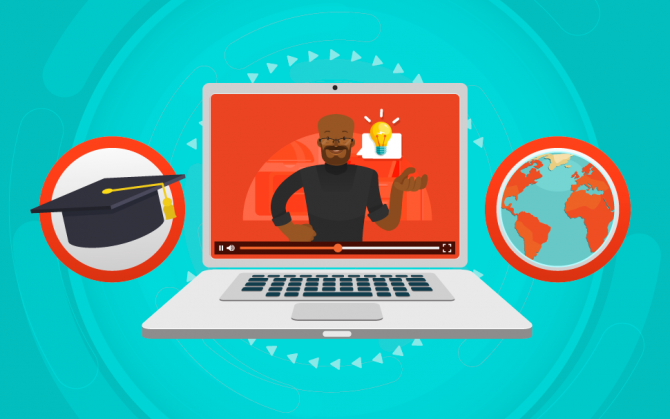
How does getting a distance education degree work?
Understand all about getting a higher education degree online and learn about its advantages for teachers.

What will we see in this post
A study done by the Online Business School (OBS) indicates that, by 2019, about 50% of the world’s higher education will be taught through E-Learning.
Therefore, not only are more people looking at distance education when getting a degree, but also there’s been a steady growth in Distance Education (DE) open online courses.
The possibility of studying from pretty much anywhere is one of the main reasons that lead people to choose this learning method.
But despite the success among the public that wants to study from a distance, it still raises questions among teachers who may wonder if the digital market is indeed an option for them to work at.
In this post, we are going to explain how Distance Education works and we’ll show you the main advantages it brings to teachers.
What is a distance education course?

Online courses are recorded digital video lessons used to teach content without the students and teacher being necessarily in the same physical environment at the same time.
Video lessons are ideal for a person who wishes to share knowledge, especially for subjects which need clear and detailed explanations, precisely because they allow the teacher to develop the content as if in a classroom.
But even if the material is simpler, you can also explore the option of videos that are sure to make the content more attractive to the student.
Due to the possibility of exploring detailed, dynamic classes in this type of material, universities have been increasingly investing in undergraduate distance learning courses.
They are useful not only for the student community but also to the faculty members, who can teach a larger number of students at the same time and without having to leave the house every day (we’ll talk more about these advantages throughout this text).
How does distance education work?
There are two types of DE undergraduate courses:
- Blended learning: in this program, the course is divided between traditional classroom methods and online classes. This is a great option for those who want to get a distance college degree, but don’t want to totally give up face to face contact with teachers and other students.
- At a distance: the graduation can be done totally online or with a minimum of 80% of the activities in the digital format. Distance learning courses are ideal for those who want to study and at the same time work or engage in other activities.
Just like every undergraduate course, there are some processes involved in distance education.
We will go through all of them below:

1. Admission process
The selection process of a distance college depends on each educational institution and its country of origin.
There are some universities that apply face-to-face or online exams, others analyze the candidate’s CV (or résumé), or even accept a national exam, such as the SATs, as a form of admission.
In addition, it’s also possible to apply for scholarships, even if you choose to study at a distance.
Regardless of the admission process, it’s necessary that the student completes high school before going for a degree in DE.
2. Online classes
All classes offered in the distance education are online, except for blended learning courses, which do have some face-to-face meetings.In addition to previously recorded content, there is also the possibility of making live broadcasts and webinars, formats that allow instant interaction between students and teachers.
3. Virtual learning environment
The Virtual Learning Environment (VLE) is a system that has been developed to enable the management of online classes.
It is in the VLE that all the material of the online course is stored.
By accessing this environment, students have access to the classes, while also being able to do tests and letting the teacher know about a specific doubt, for example, since this system offers resources like quizzes and forums.
4. Evaluation system
Everything, from the number of accesses to classes, how long videos were watched for, to following up on forum participation, can be used to evaluate a student who is seeking to earn his degree at a distance.
Moreover, there are also online tests, projects and, in some cases, face-to-face tests.
In order to do that, it’s necessary for the educational institution to make a physical space available, which would enable students and teachers to meet for face-to-face activities.
The face-to-face assessment is more common in blended courses.
5. Online teacher
Teachers chosen to teach at a distance college are no less prepared than any other tutor at a university.
Unlike open online courses, in which any person with knowledge in a specific area can give lessons, in the DE undergraduate courses, the teacher needs to be trained in the subject that he will teach.
In addition to sharing all their knowledge in online classes, teachers are primarily responsible for the discipline.
That is, they plan the materials that will be used, the projects requested and evaluations applied, and follow up on the class to solve the main questions that arise during the course.
6. Learning material
There are various educational technologies the teacher may make use of when teaching at a distance, and the teaching materials’ formats vary greatly.
You can find interactive infographics, ebooks, audiobooks, videos on YouTube and more, in addition to the video lessons that are offered throughout the course.
7. Diploma
When you choose a higher education institution, it’s important that you do a thorough research to check if they offer a valid, official degree accepted by the education department in each respective country.
That way, you can count on a recognized diploma that has the same worth as that of face-to-face courses.

What are the advantages of a distance college?
If you are a teacher and already working in the field, you must be asking yourself:
Why should I tailor my classes to DE?
We’ll now walk you through the main advantages for those who want to teach at a distance college. Check them out:
Manage your own time
As the lessons taught will be recorded at an earlier time, you can have time flexibility, and you can manage your schedules the way you see fit.
You may shoot all the classes in one week only, for example, and for the rest of the semester, you’d only have to set aside a few hours of your day to answer students’ questions and evaluate their activities.
This means that you’d no longer have to follow a fixed schedule since you wouldn’t have to commute every day.
Work from anywhere
After creating your video lessons, which is the part that requires you to be in a specific location to shoot the videos, it’s no longer necessary to leave the house to teach anymore.
In other words, online teachers can work from anywhere in the world, really, as long as they have access to the internet.
Save up
Although they seem like small expenditures, items like transportation and food can end up being more expensive than planned, especially if you have to spend the whole day away from home.
When teaching at DE undergraduate courses, the teacher manages to save up on these items. There’s also, of course, the time-saving factor on commuting, since it’s not necessary to spend hours in traffic to reach the education institution.
Improve the teaching/learning process
As with any undergraduate course, classes taught at a DE college also have a schedule to be followed by each student.
However, the advantage of having classes that are always available enables students to study at their own pace. That is, if there they have doubts about any part of the lesson, it’s possible to go back to that subject several times until they have understood everything.
And why is that an advantage for the teacher?
Because they can think of effective actions for each student, mainly using their questions as the basis. Besides, the teacher can think of ways to make their lessons clearer from the received feedback.
How to teach online

Now that you’ve figured out how distance college works, and the key benefits of teaching online, you must be wondering what you need to do to be a DE teacher.
If you want to work with undergraduate courses, the first step is to get your own degree in a subject that you are interested in.
If you already have a degree and already work in a university, you can check with the dean if the institution offers this type of education.
If the answer is yes, you’ll need to tailor the content you already teach in a way that will fit the video format.
The next steps will probably be taken by the university itself, which will record your lessons and make them available in a virtual teaching environment.
Another option is to create your own online course, even if it’s not for a university.
To do that, you can follow these steps:
- Choose a subject to address in your course;
- Write a script for your classes;
- Invest in recording equipment such as a camera, microphone, and a set/studio;
- Record the lessons;
- Edit your material;
- Host your classes on a DE platform;
- Promote your course to potential buyers.
Are you interested in teaching online undergraduate courses? Let us know if you have any questions!




